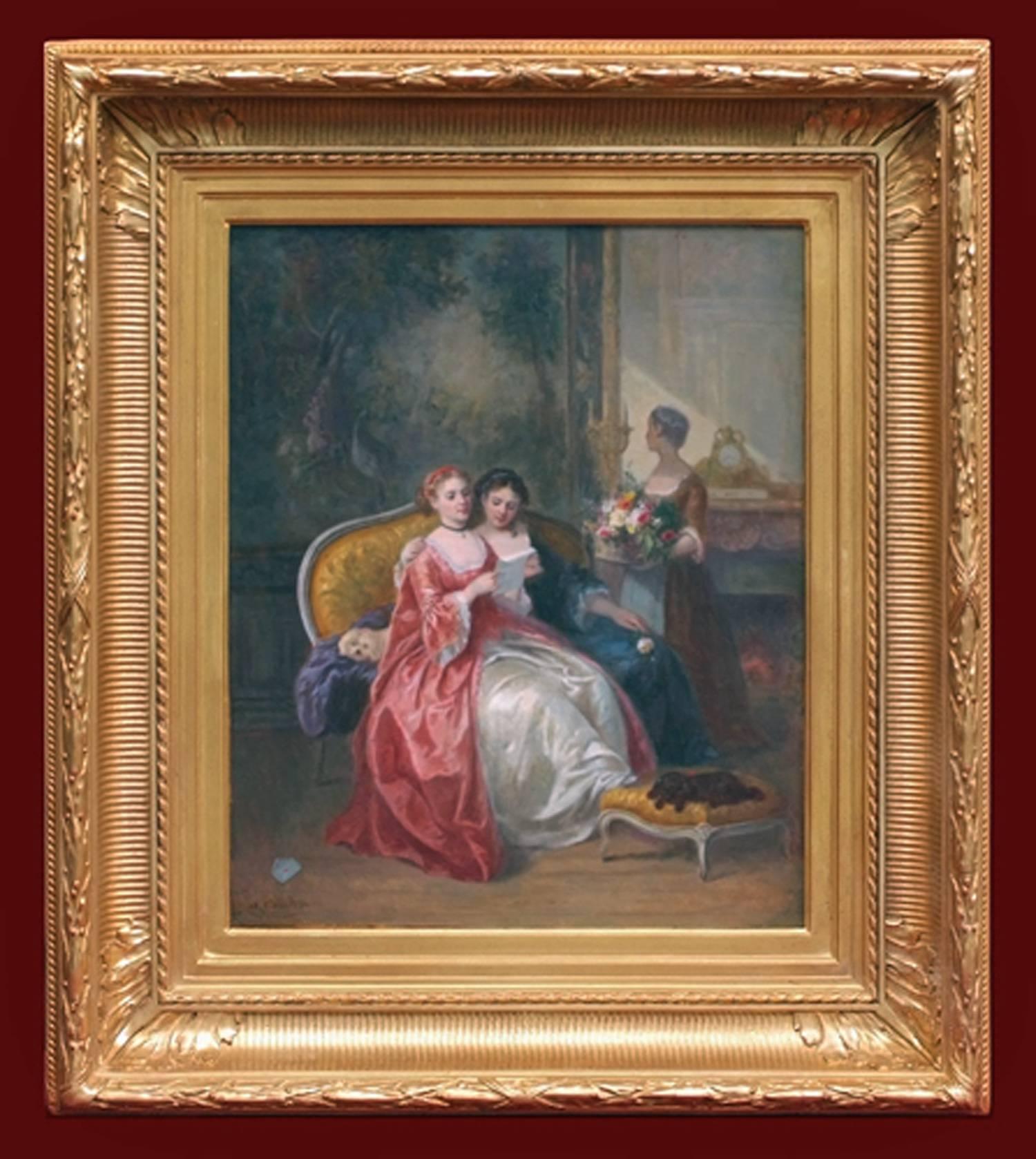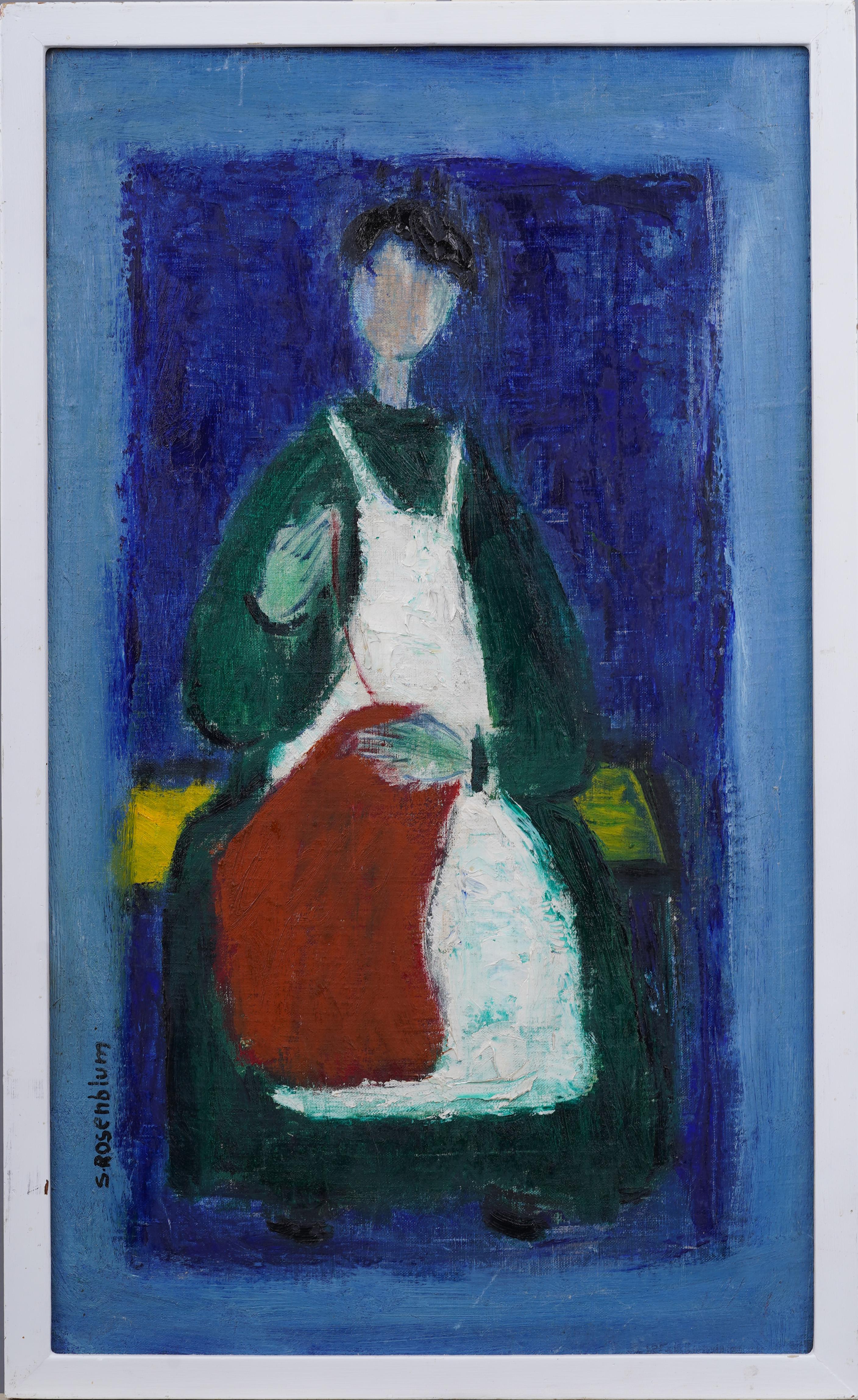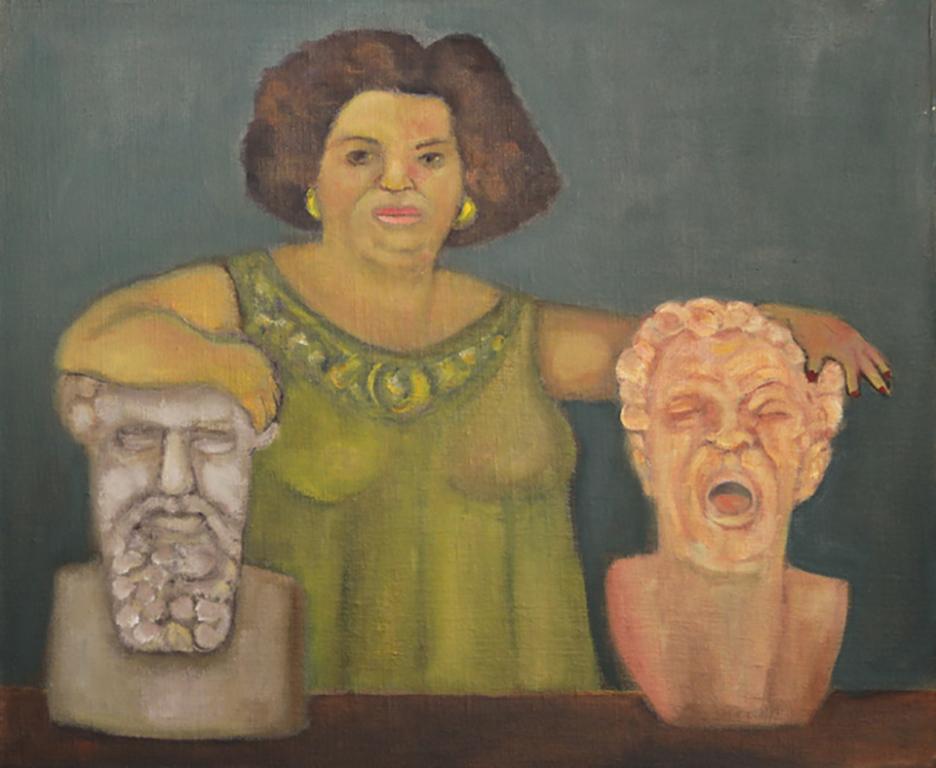Items Similar to 18th century portrait of the artist’s daughter, Catharina, playing the cello
Video Loading
Want more images or videos?
Request additional images or videos from the seller
1 of 13
Balthasar Denner 18th century portrait of the artist’s daughter, Catharina, playing the celloc.1730
c.1730
About the Item
The sitter, seated in a yellow silk gown trimmed with a pink bow playing the cello, is believed to be the artist Balthazar Denner's eldest daughter Catharina (1715-1744), after his marriage to Esther Winter in Hamburg in 1712. She is also recognisable in another portrait of the Denner family in the Hamburg Kunsthalle, painted circa 1740 by the artist's son, Jacob Denner (1722-1765). Oil on canvas in a period giltwood frame.
Provenance: Private collection, Northern Germany
Professor Helmut Borsch-Supan, Berlin, confirmed the authenticity of the painting after examining it in 2013. The painting will also be included in the forthcoming catalogue raisonnée of the artist, by Ute Mannhardt.
Balthasar Denner was born in Hamburg which was at that time part of Denmark. He began as a painter of portrait miniatures and his eye for detail continued into his larger scale portrait paintings which were greatly admired for their meticulous accuracy and made him highly sought after. Denner is recorded as being at the Prussian Academy of Arts in Berlin in 1707 before going to work at the Copenhagen court in 1712. This began his travels around the European courts, including London, Dresden, Berlin, Kiel and Amsterdam. After four years in Amsterdam from 1736 to 1740, he settled in Rostock where he died in 1749.
Denner loved music and it is said that he had his children, who were talented musicians, play for him while his sitters posed for their portraits. As well as the royals and nobles of Europe, his sitters included Georg Friedrich Handel, painted in 1726 (National Porttrait Gallery London) and in 1733 (Berlin, Deutsch Historiches) and Johann Sebastian Bach with his three sons (1733, private collection).
Denner depicted his own family playing music in a painting probably painted in London in 1728 before his departure for Germany (now in the Copenhagen Museum).
- Creator:Balthasar Denner (1685 - 1749, German)
- Creation Year:c.1730
- Dimensions:Height: 34.65 in (88 cm)Width: 29.53 in (75 cm)
- Medium:
- Movement & Style:
- Period:
- Condition:
- Gallery Location:Bath, GB
- Reference Number:1stDibs: LU9528554492
About the Seller
5.0
Vetted Seller
These experienced sellers undergo a comprehensive evaluation by our team of in-house experts.
Established in 2002
1stDibs seller since 2015
37 sales on 1stDibs
Typical response time: 1 hour
Associations
The British Antique Dealers' AssociationLAPADA - The Association of Arts & Antiques DealersInternational Confederation of Art and Antique Dealers' Associations
- ShippingRetrieving quote...Ships From: Bath, United Kingdom
- Return PolicyA return for this item may be initiated within 3 days of delivery.
More From This SellerView All
- 17th century Dutch portrait of a Lady in Red adorned with PearlsBy Pieter NasonLocated in Bath, SomersetPortrait of a lady, half-length in a feigned oval wearing a ruby coloured silk gown holding entwined strings of pearls across her bodice. Signed 'PNason' and dated 1667 (lower right)...Category
17th Century Old Masters Portrait Paintings
MaterialsOil, Canvas
- 17th century portrait of lady in an ivory silk gown and lace collarBy Cornelius JohnsonLocated in Bath, SomersetCircle of Cornelius Johnson (1593-1661), a 17th century portrait of a lady, bust-length oval, wearing an ivory silk gown with blue silk bows and lace c...Category
Early 17th Century Old Masters Portrait Paintings
MaterialsOil, Canvas
- 18th century painting of the Dalbiac family in the gardens of a country houseBy Charles PhilipsLocated in Bath, SomersetThe painting depicts James (Jacques) Dalbiac, his wife Louise (ne de la Porte) and their five children, James, Charles, Louise, Marianne and Martha in the ornamental gardens of a grand country estate. The extensive gardens extend into the distance with gardeners working in the background and figures strolling through the avenues of trees. A peacock and peahen can be seen on the wall to the left and a potted orange tree to the right. Louise Dalbiac holds an orange taken from the orange tree, aluding to the family's faith and their loyalty to the protestant King William of Orange and their adopted country. The Dalbiacs were wealthy London silk and velvet merchants of French Huguenot origin who had fled France at the end of the 17th century to escape persecution for their protestant faith. England offered safe refuge and their skills and industriousness allowed them to establish one of the most successful businesses in London's Spitalfields which became a new centre of the silk trade, effectively leading to the collapse of the once dominant French silk industry. Both sons, James and Charles followed their father and Uncle into the family business, successfully growing the family's fortune and each going on to own their own country estates. A conversation piece is a genre of painting used to describe group portraits of families and friends, often depicted with their servants and family pets and set within an elegantly furnished interior or the garden of a grand country house. They were a celebration of the intimacy of family relations as well as a sign of status, property and the power of succession. The informality of conversation pieces grew popular in 18th century England, allowing the sitters to present themselves in a more relaxed pose, perhaps engaged in intellectual conversation or showing their talents or interests. In this present portrait, the Dalbiacs are shown richly dressed and and at leisure in a grand country house setting, conveying their success and cultural and social aspirations. Charles Philips (c.1703–1747) was an English artist known for painting a number of portraits and conversation pieces for noble and Royal patrons in the mid-eighteenth century. He was the son of portrait painter Richard Philips...Category
Early 18th Century Old Masters Portrait Paintings
MaterialsCanvas, Oil
- English 17th century portrait of James Thynne as a young boy by a fountainBy Johann KerseboomLocated in Bath, SomersetPortrait of the Hon. James Thynne (c. 1680-1704), full-length, in the gardens of Longleat House, seated beside a fountain, holding a shell beneath water spouting from a horn blown by a cherub on a dolphin. A glimpse of part of Longleat House can be seen upper left. Oil on canvas in a period giltwood frame, decorated with leaves and acorns. C. 1682. Dimensions: 145 x 123cm (57 x 48in) in frame Provenance: Ex Longleat House, Wiltshire Private collection, Bath James Thynne was the youngest son of Thomas Thynne, 1st Viscount Weymouth and Frances Finch of Longleat House, Wiltshire. He died in his youth and his Aunt, Anne Kingsmill Finch, Countess of Winchilsea (1661-1720), wrote a moving poem on his death. He was buried in the family vault at Longbridge Deverill, Wiltshire. A mezzotint of this painting by William Faithorne the Younger is held in the Royal Collection. Johann Kerseboom (d.1708) was the nephew of Frederick Kerseboom and first worked in Germany before coming to England in the 1680's where his sitters included the 'Electress Sophia Dorothea' (known from a mezzotint by William Faithorne). His early works were influenced by William Wissing...Category
17th Century Old Masters Portrait Paintings
MaterialsOil, Canvas
- Attributed to John Riley, 17th century English portrait of a girl on a terraceBy John RileyLocated in Bath, SomersetPortrait of a young girl, full-length, wearing a blue silk gown, standing on a terrace beside a classical urn holding a branch with blossom. Attributed to John Riley...Category
17th Century Old Masters Portrait Paintings
MaterialsOil, Canvas
- English 18th century portrait of Henrietta Pelham-Holles, Duchess of Newcastle.By Charles JervasLocated in Bath, SomersetPortrait of Henrietta Pelham-Holles (née Godolphin) (1701-1776), Duchess of Newcastle, standing in a wooded landscape with a river beyond, three-quarter length wearing an ivory silk ...Category
1720s Old Masters Portrait Paintings
MaterialsOil, Canvas
You May Also Like
- Painting 19th Century Romantic Courtiers Genre SceneLocated in Saint-Ouen, FRCourtiers Party in the Park in 18th Century In the Taste of Nicolas Lancret (1690-1743) Oil on canvas Frame gilded with leaves Dim canvas : 73 X 59 cm Dim frame : 100 X 87 cmCategory
1850s Old Masters Portrait Paintings
MaterialsOil
- Painting 19th century old master rural daily lifeBy Henri-Joseph CastaingLocated in Saint-Ouen, FRCASTAING Henri Joseph (1860-1918) Young girl at the source Oil on canvas signed low left Frame gilded with gold leaves Dim canvas : 100 X 66 cm Dim frame : 121 X 86 cm CASTAING Henr...Category
1890s Old Masters Portrait Paintings
MaterialsOil
- 19th Century Painting Interior and Genre SceneBy Jean Alexandre Rémy CouderLocated in Saint-Ouen, FRCOUDER Alexandre Jean Rémy (1808-1879) Reading on the sofa Oil on canvas signed low left Old original frame gilded with leaves Dim canvas : 47 X 39 cm Di...Category
1860s Old Masters Interior Paintings
MaterialsOil
- Vintage Signed Exhibited American Female Modernist Woman Sewing Framed PortraitLocated in Buffalo, NYNicely painted mid century modernist interior portrait oil painting by Sadie Skoletsky Rosenblum 1899-1987. Great color and composition. Framed.Category
1940s Modern Interior Paintings
MaterialsCanvas, Oil
- the greco roman question, figure with classical statues, greens, earth tonesBy Stephen BassoLocated in Brooklyn, NYOil on canvas, humorous depiction of a woman with classical artworkCategory
2010s Neo-Expressionist Portrait Paintings
MaterialsCanvas, Oil
- The RecitalBy John Arthur LomaxLocated in Belgravia, London, LondonOil on canvas Canvas size: 12 x 10 inches Framed size: 18.25 x 16 inches Signed lower leftCategory
19th Century Portrait Paintings
MaterialsCanvas, Oil
Recently Viewed
View AllMore Ways To Browse
The Den
Master Of The Die
Portrait Musician
European Painting 18th Century
Antique Portrait Miniature
Portrait Of Danish
Framed Miniature Portraits
Early Dresden
Old Danish Paintings
Antique Portrait Miniature Painting Paintings
Antique Portrait Miniature Paintings
Antique Miniature Portrait Painting
Large Danish Oil Painting
Jacob And Son
Large Pink Bow
Royal Copenhagen Yellow
Pink Dior Gown
Cello Antique





